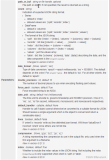JSON(JavaScript Object Notation,JavaScript 对象表示法),是存储和交换文本信息的语法,类似 XML。
JSON 比 XML 更小、更快,更易解析,更多 JSON 内容可以参考 JSON 教程。
Pandas 可以很方便的处理 JSON 数据,本文以 sites.json 为例,内容如下:
实例
[ { "id": "A001", "name": "菜鸟教程", "url": "www.runoob.com", "likes": 61 }, { "id": "A002", "name": "Google", "url": "www.google.com", "likes": 124 }, { "id": "A003", "name": "淘宝", "url": "www.taobao.com", "likes": 45 }]
实例
import pandas as pd
df = pd.read_json('sites.json')
print(df.to_string())
to_string() 用于返回 DataFrame 类型的数据,我们也可以直接处理 JSON 字符串。
实例
import pandas as pd
data =[
{
"id": "A001",
"name": "菜鸟教程",
"url": "www.runoob.com",
"likes": 61
},
{
"id": "A002",
"name": "Google",
"url": "www.google.com",
"likes": 124
},
{
"id": "A003",
"name": "淘宝",
"url": "www.taobao.com",
"likes": 45
}
]
df = pd.DataFrame(data)
print(df)
以上实例输出结果为:
id name url likes
0 A001 菜鸟教程 www.runoob.com 61
1 A002 Google www.google.com 124
2 A003 淘宝 www.taobao.com 45
JSON 对象与 Python 字典具有相同的格式,所以我们可以直接将 Python 字典转化为 DataFrame 数据:
实例
import pandas as pd
# 字典格式的 JSON
s = {
"col1":{"row1":1,"row2":2,"row3":3},
"col2":{"row1":"x","row2":"y","row3":"z"}
}
# 读取 JSON 转为 DataFrame
df = pd.DataFrame(s)
print(df)
以上实例输出结果为:
col1 col2
row1 1 x
row2 2 y
row3 3 z
从 URL 中读取 JSON 数据:
实例
import pandas as pd
URL = 'https://static.jyshare.com/download/sites.json'
df = pd.read_json(URL)
print(df)
以上实例输出结果为:
id name url likes
0 A001 菜鸟教程 www.runoob.com 61
1 A002 Google www.google.com 124
2 A003 淘宝 www.taobao.com 45
内嵌的 JSON 数据
假设有一组内嵌的 JSON 数据文件 nested_list.json :
nested_list.json 文件内容
{
"school_name": "ABC primary school",
"class": "Year 1",
"students": [
{
"id": "A001",
"name": "Tom",
"math": 60,
"physics": 66,
"chemistry": 61
},
{
"id": "A002",
"name": "James",
"math": 89,
"physics": 76,
"chemistry": 51
},
{
"id": "A003",
"name": "Jenny",
"math": 79,
"physics": 90,
"chemistry": 78
}]
}
使用以下代码格式化完整内容:
实例
import pandas as pd
df = pd.read_json('nested_list.json')
print(df)
以上实例输出结果为:
school_name class students
0 ABC primary school Year 1 {'id': 'A001', 'name': 'Tom', 'math': 60, 'phy...
1 ABC primary school Year 1 {'id': 'A002', 'name': 'James', 'math': 89, 'p...
2 ABC primary school Year 1 {'id': 'A003', 'name': 'Jenny', 'math': 79, 'p...
这时我们就需要使用到 json_normalize() 方法将内嵌的数据完整的解析出来:
实例
import pandas as pd
import json
# 使用 Python JSON 模块载入数据
with open('nested_list.json','r') as f:
data = json.loads(f.read())
# 展平数据
df_nested_list = pd.json_normalize(data, record_path =['students'])
print(df_nested_list)
以上实例输出结果为:
id name math physics chemistry
0 A001 Tom 60 66 61
1 A002 James 89 76 51
2 A003 Jenny 79 90 78
data = json.loads(f.read()) 使用 Python JSON 模块载入数据。
json_normalize() 使用了参数 record_path 并设置为 ['students'] 用于展开内嵌的 JSON 数据 students。
显示结果还没有包含 school_name 和 class 元素,如果需要展示出来可以使用 meta 参数来显示这些元数据:
实例
import pandas as pd
import json
# 使用 Python JSON 模块载入数据
with open('nested_list.json','r') as f:
data = json.loads(f.read())
# 展平数据
df_nested_list = pd.json_normalize(
data,
record_path =['students'],
meta=['school_name', 'class']
)
print(df_nested_list)
以上实例输出结果为:
id name math physics chemistry school_name class
0 A001 Tom 60 66 61 ABC primary school Year 1
1 A002 James 89 76 51 ABC primary school Year 1
2 A003 Jenny 79 90 78 ABC primary school Year 1
接下来,让我们尝试读取更复杂的 JSON 数据,该数据嵌套了列表和字典,数据文件 nested_mix.json 如下:
nested_mix.json 文件内容
{
"school_name": "local primary school",
"class": "Year 1",
"info": {
"president": "John Kasich",
"address": "ABC road, London, UK",
"contacts": {
"email": "admin@e.com",
"tel": "123456789"
}
},
"students": [
{
"id": "A001",
"name": "Tom",
"math": 60,
"physics": 66,
"chemistry": 61
},
{
"id": "A002",
"name": "James",
"math": 89,
"physics": 76,
"chemistry": 51
},
{
"id": "A003",
"name": "Jenny",
"math": 79,
"physics": 90,
"chemistry": 78
}]
}
nested_mix.json 文件转换为 DataFrame:
实例
import pandas as pd
import json
# 使用 Python JSON 模块载入数据
with open('nested_mix.json','r') as f:
data = json.loads(f.read())
df = pd.json_normalize(
data,
record_path =['students'],
meta=[
'class',
['info', 'president'],
['info', 'contacts', 'tel']
]
)
print(df)
以上实例输出结果为:
id name math physics chemistry class info.president info.contacts.tel
0 A001 Tom 60 66 61 Year 1 John Kasich 123456789
1 A002 James 89 76 51 Year 1 John Kasich 123456789
2 A003 Jenny 79 90 78 Year 1 John Kasich 123456789
读取内嵌数据中的一组数据
以下是实例文件 nested_deep.json,我们只读取内嵌中的 math 字段:
nested_deep.json 文件内容
{
"school_name": "local primary school",
"class": "Year 1",
"students": [
{
"id": "A001",
"name": "Tom",
"grade": {
"math": 60,
"physics": 66,
"chemistry": 61
}
},
{
"id": "A002",
"name": "James",
"grade": {
"math": 89,
"physics": 76,
"chemistry": 51
}
},
{
"id": "A003",
"name": "Jenny",
"grade": {
"math": 79,
"physics": 90,
"chemistry": 78
}
}]
}
这里我们需要使用到 glom 模块来处理数据套嵌,glom 模块允许我们使用 . 来访问内嵌对象的属性。
第一次使用我们需要安装 glom:
pip3 install glom
实例
import pandas as pd
from glom import glom
df = pd.read_json('nested_deep.json')
data = df['students'].apply(lambda row: glom(row, 'grade.math'))
print(data)
以上实例输出结果为:
0 60
1 89
2 79
Name: students, dtype: int64


